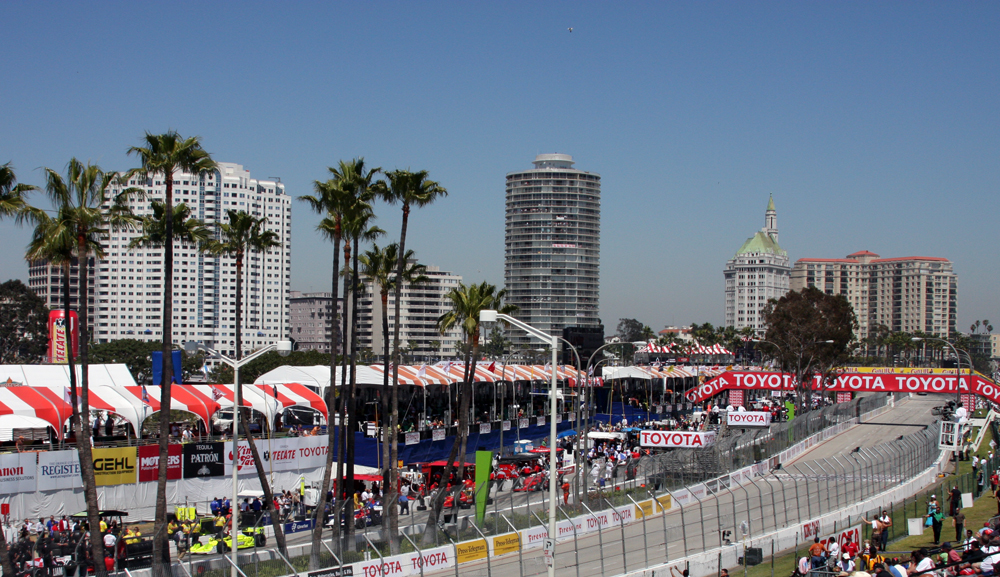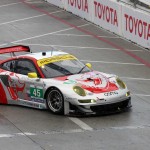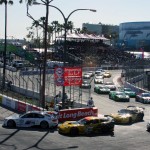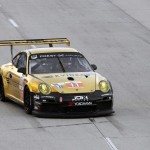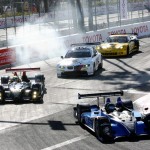
Patrick Long, Flying Lizard Motorsports
I was fortunate to sit and talk with Patrick Long, factory Porsche and Flying Lizard Motorsports #45 driver, on the day before the 2012 ALMS race in Long Beach. Rain was pouring down in buckets, and it looked like a wet qualifying session was in the offing a couple of hours later. As it turned out, qualifying was cut short by more heavy rain after a brief bit of sunshine, and IMSA reverted to standings for the grid – which was essentially Sebring results. Patrick gave some great insights on racing strategy, racing with multiple classes on track, his career, the competition, the new 911 RSR, and race preps. Unfortunately on Saturday, while charging through the pack – thanks to a poor grid position resulting from their Sebring misfortune – Patrick suffered a cut tire caused by carbon fiber debris from an earlier incident between other cars. He had moved up from tenth on the grid to fourth when the unexpected pit stop ruined their chances for a podium. Teammate Joerg Bergmeister took over for Patrick just past the halfway point and ultimately finished seventh.
Chet: What happened at Sebring?
Patrick Long: No coverage of it. Joerg just came over the radio and said ‘What the hell? I’m sorry – i don’t know what happened.’ We talked to Dominick Farnbacher who’s close to the Porsche family, and he couldn’t really explain what happened. Everyone checked up going into last corner, and that was it.
Chet: I’m amazed you could fix #45 and still take green within the hour…
Patrick Long: You know that’s a mixed emotion deal. That’s a new rule in IMSA that you can get back under someone else’s power – ie, a flatbed. Usually under ACO rules if you cannot make it back to the pits yourself, you’re done. So it’s a new rule. It helped us a lot because the main goal becomes getting to 70% so you can score points, and we were able to achieve that, so that’s really good, because starting with a 0 at Sebring is really hard to recover from. Starting with anything below a podium is very difficult, but Sebring has not been good to the Flying Lizards. Hasn’t been good to me really since 2005 with Peterson. Snakebit always with Penske. Finished on the podium with Tafel in ’07, but with Flying Lizards, its been… It’s been very close – we’ve had the speed and strategy and all that to get there in certain years, but it’s just slipped out from underneath us every time.
Chet: When that happens, do you change the way you drive mentally the rest of the race just to survive?
Patrick Long: No, not so much. What you don’t want to do is go for 12 hours just cruising around because you’re actually more prone to a mistake by driving around at less than full focus and full pace, but you do have to be more wary of the race that’s going on that you’re not involved with. Because often times if you are selfish about that or get into other people’s business, it comes back to you twice in the future. Drivers remember – they’re like elephants. So you’re just very respectful to your competition who are on the lead lap regardless of how quick might be are or how much you want to be on TV. You just have to have that respect. Other than that we push pretty hard for a lot of reasons – development, setup, to know what could have been with how hard we worked in the off season.
Chet: What do you think about the WEC & ALMS together on the track at the same time?
Patrick Long: I think that’s good. First of all, in sports car racing it’s such a fragmented, complex equation. So many different series, so many different classes – here, there, everywhere. Class names, series names – everything always changes – it’s a moving target. I realize there are two sides to the story. There’s our side where we’re like, ‘I don’t get it, why is there every single acronym ever known to man. Why can’t we just simplify this?’ But I also understand the sanctioning body and trying to make it more understandable and trying to make it attractive to new teams and sponsors. I just wish there could be some uniformity.
To your question – maximum starting entry at Sebring is great. It was supposed to be more of a headache than it actually turned out to be. Of course we had lots of yellows, but that’s always part of Sebring. Practice was easier to navigate than we would have expected. You don’t really get a clear lap. I’m sure the prototypes had a more difficult job than we did in GT. It did add to confusion of classes and finishing order and the podium ceremonies. I think you’ll see less of that in the future. I think everyone’s decided that if the WEC is going to do their thing and want to be who they are, they need to exist on their own. I think it’s a testament to American racing to American Le Mans Series and Sebring that they want to be part of the club. It shows how much of an icon that race is.
Chet: I guess you also hope that someone who is in one of the other classes that’s not even in the ALMS race doesn’t affect the outcome – like almost happened?
Patrick Long: Yeah, exactly. That move was uncalled for and really just shows a lack of integrity or understanding of the whole way the world works. There may be more to the story but to the outsiders perspective it was bad. You know there is a different culture in racing – I lived for a while and raced over there, and it is much different. You know in the paddock and also on the track, for better or for worse it’s just different. So I see that – it’s more of a cutthroat nature in European sports car racing. It’s probably not seen as regretful to them as maybe it was to the rest of the US contingent.
Chet: Can you be friends with guys on the other teams in the paddock?
Patrick Long: Yes, you can. More so in this culture, in the US/North American culture; less so in the European culture. You know I had a mentor, Kenny Brach, and I asked Kenny when I was a 19-year old aspiring driver, ‘So how does it work amongst you and all the other IndyCar drivers?’ And he said, ‘Well, the way I see it, the fewer friends I have that are competition, the fewer times I’m going to have to second guess you know, putting a wheel into a guy come the last lap, last turn.’ I came over from Europe hardened after 7 seasons and not really putting my best foot forward to reach out and meet my coworkers. I was enlightened by a mentor of mine who just said, ‘Look you might not know that person officially, but you guys are all feeling the same thing. You’re all on the road 300 days a year. Your families are at home. And this is your office. You might not know every department, but at you can at least have the respect of others and give the respect to others, but still be competitive.’ So I’d say that Corvette and the ESM guys, and there’s a lot of guys out there – the Falken guys – they’re main competitors of ours, but we still have a great amount of respect, and we still really get on well. I’d say I have about the middle of the road to fewer paddock friends, per se. The people I have the most in common with are usually inside these walls. So it’s a balance. To me it’s more individual.
Chet: Do you miss competing with the Risi guys?
Patrick Long: Yes, who’s to say they won’t be back, but I certainly will miss that if they don’t come back. It got sticky there last year at Laguna, and there’s a few things that I’m not thrilled by, but I know they’re not thrilled with a few of my choices, and I think that’s what a real rivalry is about – its coming together and moving apart and keeping everyone on their toes. Great, great competitors and a really, really different mentality in that organization – very unique. And I think people would say that about the Lizards as well. So hopefully it holds a little piece of the sportscar history book.
Chet: You have had a great rivalry – there’s been some great battles between you guys – and it’s not good for ALMS that they’re not here?
Patrick Long: As brutal as it has been, and as intense as it might have seemed, that’s actually one organization where at least the crew guys – a lot of the energy that we follow is based on the interaction of our respective crews. The drivers are kind of like high school kids. But with the crew guys you can see which organizations really radiate integrity because they respect each other.
Chet: Plus they have had a complete turnover of drivers there since some of the most intense things happened, right?
Patrick Long: There are certain people that have come thru those doors on the driver’s side that are just awesome. There are others who have a bigger more personal agenda that we don’t miss as much.
Chet: You mentioned about your time in Europe; tell me about your path to being Porsche’s only American factory driver.
Patrick Long: My ticket from Southern California, wheels-and-engines, crazy toddler to being employed by a company such as Porsche really comes down to opportunity and more specifically competing against the best. And it raised my game thru osmosis and exposure. I don’t believe if I took the traditional Americana route of road racing that I would be employed as a professional today. And that’s nothing against our ladder system or our drivers or our teams. It’s just that I don’t consider myself a phenom, genetic freak of nature. I think that I got to where I did because I had people who were willing to take a chance on me who saw something and were willing to give me a shot. It started with my family – with my Dad specifically leveraging every dollar he’s ever earned out of a woodshop that started in our garage – to go kart teams to just people who really took me under their wing for no apparent reason other than to try to help out a hungry kid. But Europe is what solidified it all because at the go kart level and the junior formula level it’s the best kids from every respective country in the world in one little rainy, foggy island of the UK. That was sink or swim for me. There were a couple of touch and go seasons or parts of seasons where I was laying in my bedroom that I was renting from a lady and just asking myself, ‘am I cut out for this’, ‘what is it going to take’ and just stuck with it. The timeline is go karts locally, regionally, state, national, toe-in-the-water exercises international, full time international, and then the formula ladder. Never had the money. There were a couple of contracts put in front of me where I could have signed my life away for 25% of my career and had money infused into a bank account and had managers and all that stuff. But I always remained primarily independent, and that was probably a good thing. Sitting today it would be hard to write a check – a portion of every dollar that I worked hard for – to someone who invested in me, but I understand that there’s a trade off. The last part of the question would be the real pinnacle was being selected by Red Bull for their inaugural Formula 1 US driver search. It’s a group of 16 that had people like Hunter-Reay, Almendinger, Speed and Giebler, all the people I grew up racing hard against. Most were Californian. And at that point – I still consider myself immature – at 21 years old I was mature enough to understand that all 16 of us were going to come out way ahead of where we went into that deal. There were only going to be a couple of winners, but every single one of us was going to have the steps we needed in that ‘burst onto the scene’ type ride. And sure enough – I kept my options open because I had been through so many of those driver selection things, and it’s a crap shoot and you’re trying to look into a crystal ball and see where do you put your money on for your future. It’s like looking at a bunch of puppies and trying to decide which one is going to be the best dog playing catch with. You’re just grasping for little clues. So along that way I met the Porsche guys – Uwe Brettel who was head of SuperCup and all the one make Cups and the junior team, and his colleague Helmut Greiner who really grandfathered the whole UPS junior team that brought Lucas Luhr, Timo Bernhart, Marc Lieb, Marco Holzer, and Mike Rockenfeller along. I met those guys, and I put a lot of energy into finding out who they were and spending some time with them where I’d say some kids in that program were just destined in their minds for Formula 1 and no one else mattered. Red Bull was the only way to the top and piss on anybody else who wants a piece of them – they were there for one reason. And a lot of those kids made it, and that was their issue. I just thank my lucky stars that Porsche saw something in me, and we connected more on a personal level than what they saw on a race track. Uwe Brettel is here this weekend who runs international motorsport. He’s the guy who took the chance on me from day one. They wanted an American, but they didn’t know where to access one.
Chet: You make it look so easy: the pass on BMW 2 years ago at LB, chasing down opponents at Laguna Seca – what’s the toughest thing for you behind the wheel?
Patrick Long: Behind the wheel is walking that line. The difference between between hero and zero at this level – that line is so small and so fine. Every level that I went up in my career – even in sports car realms of different series. Right now, ALMS, this era in GT racing, I am biased to say that there has never been anything like this since I have been around as far as competition. So the hardest thing is – if we could just throw caution to the wind and pump our chests up and do whatever came to mind, and then just put a reset button on it if we screwed up, it would be a whole different game. But because you’re dealing with a piece of machinery that’s worth close to a million bucks and you’ve got other lives on the line, you have to be very selective in a split second, fighter pilot type decision. We take some of the fun out of racing. Fun to me know is being out with my friends on a vintage weekend or POC or PCA event and just barbequeing and driving, but there’s nothing really death defying on the line. These days this is what I love, and subconsciously it’s still my fun, but consciously it’s high stakes, high intensity. So that’s the toughest part. The off the track stuff is just a dream come true – from media to engineering to conditioning strength – all that type of stuff is what I always worked for. But it’s tough right now. No one’s going to deny that we’re behind the eight ball. We rode a three-year glory train where we could do no wrong. we won five in a row; it was our heyday. And we’re doing our best to bring that back, but we’re not there right now. And last year was a completely grounding, humbling scenario of situations for all of us, team-wide. But certainly for myself – I can speak for myself – that it put me back to a realm of reality where I just had to look in the mirror and say, ‘you thought you were invincible, you thought you were the best.’ But we’re all human. Things go our way some days and other days they don’t, and lots of things are in your control and lots of things aren’t. Sometimes that’s just how the cards fall. We were sitting at that blackjack table, and they kept dealing us 21. Through preparation, through timing, through hard work, through a lot of things that people deserve credit for, but I also believe there was a little bit of – I won’t use the ‘L’ word, I just think it’s over used in racing and it’s over abused. Too many sum up screw ups to luck. But I do believe you make your own fortune. And we’ll be back. This makes it so much more gratifying when we do well, because we’ve gone through so much challenge and struggle. But still, a bad day at the race track is better than a good day at a real job. We’ve got to remind ourselves of that. Results – that’s was drives us all – lap times and podiums and all that. But really, what all of us struggle from in this room and this paddock is a sickness of racing. We’re getting to do that, and if I think it was easy, it would become boring.
Chet: How is the new car; how is it different? Does it make you more competitive? Is BMW you toughest competitor right now?
Patrick Long: I would say the product that Ferrari has put on the track is the biggest challenge right now. Thru sheer pace that we saw at Sebring, but also because they’ve made their speed the good old fashioned way – with their own two hands rather than politicking. There are other manufacturers that are racing with a ton of waivers. A substantial amount of rule breaks. And without getting to far into a political discussion that’s as opinionated as any type of politics, I just give Ferrari a lot of credit for what they’ve found in pace. People can say what they want about Italian cars and about Ferrari and all the rest of it, but those guys have done a great job. And we’re right on their heels. It didn’t equate in Sebring, but I think we’ll learn more tomorrow, and as we get on into the summer months. Sebring’s its own apple and so is a street course. We’re always going to be pretty good on street courses and at Lime Rock – the smaller road courses – but when you get to the Road Americas, the Mosports, the Mid Ohios that’s kind of when the cream rises to the top, and we’re not oozing with confidence, but we know we’re a lot better than we were last year – substantially. It’s just that a lot of our competition is substantially improved as well. But that will all kind of even out as we get into the thick of the season; it’s still to early. But for us, a wider front track, a taller front tire, a much more aerodynamically efficient car – those are huge, huge steps in the right direction. It’s not just aesthetics, these guys have worked tirelessly in Weissach, and we just kind of cracking the surface. We got our car right before Sebring, and we’re going to go test after this for a few days and get into some trial and error stuff. On a race weekend your basically just fielding limited track time and trying to get everybody comfortable.
Chet: How do you determine which of you two is the qualifier?
Patrick Long: The way we work things out is to sort of split it down the middle. Tracks that Joerg really likes and the tracks I really like – kind of decide to qualify at those tracks. Some might argue maybe that’s not the best thing to do because usually the qualifying driver starts, and if it was your best track and you felt like you were really in the zone, you might want to be in at the end of the race. But we just kind of split it up half and half. The bottom line is the qualifying driver spends more time in the car during the week leading up to the race and gets more allotment of the new tires. In our internal policy we choose that before the race begins so that it doesn’t become a pissing contest or something that is a variable. We try to remove all the variables. So we do that ahead of time. It’s not one week on, one week off, but it sometimes it turns out to be like that.
Chet: In a situation like this where you have to go out in the rain, do you have historical rain setup data to qualify in the rain and then go back to historical dry setup for the race tomorrow?
Patrick Long: In a situation like this we know the ‘go-to’ two or three changes that we usually make in a certain direction on a certain part of the car for the rain. We still fine tune like we would this morning, and that would be our baseline for qualifying. We put a few changes in, and then we debrief after each session with both the #44 and #45, cross compare notes, etc., and see what we can learn. Nothing big and drastic between sessions, but sometimes in a situation we’ll make a diff change or something like that that needs to be really evaluated by the same driver. And the wild card is the way it looks now going into the race tomorrow with zero time in the dry – that’s a real roll of the dice deal. We have existing notes for years – I mean every note we’ve made for 10 years we have in files. But with this new car and the tires constantly evolving a lot of it kind of goes to what we know from Sebring and what we know gets translated from Sebring to Long Beach. There I believe we have the best guys in the business – Craig Watkins and Roland Kussmaul. They know how to just compute it and calculate and somewhat just go by intuition and gut and put something on the car that’s always good. A lot of that is a testament to difference in thinking, but the ability to listen to one another. They really balance each another; they have such different backgrounds. Roland’s an old school driver turned engineer who’s worked on everything from 959 at Dakar to 962s and GT1s and Spyders and everything else. He’s really just a 911 specialist, and bleeds Porsche literally. And then Craig has a background as a mechanical engineer. He’s very innovative and very quirky and just brilliant – I mean, intelligence beyond computing. It’s a cool setup there, and we just go with what they have to say. And Joerg is very, very technically inclined. Very switched on. He can tell you about cuts in a rain tire and how it all works. So as a driver he’s probably as knowledgeable on the engineering side as anybody in this paddock. And he’s not shy to get in their face and tell them what he wants. I consider myself one the best at giving seat of the pants, inch by inch feedback, and tipping the scales if they ask me if we should do diff or aero, but I kind of pride myself on not getting into something that’s not my expertise. I don’t want them questioning how I turn into Turn 1 or how come you turn in early or how come you exit late. Let me deal with that, and that’s kind of how I let engineers deal with their stuff. Bottom line is we’ve got a good team, and we’ll be fine tomorrow – as good as anybody. And we’ve done this before, I forget where. Actually we did it last year or the year before. We qualified in the wet, practiced in the wet at Lime Rock, and then we went straight into the race. And lucky enough we have enough laps around these tracks that lap 1you’re pretty close to the limit straight out of the box. You don’t need ten laps to get up to speed. That’s one of those expectations that at this level it’s incumbent upon you. And honestly we have enough laps and enough pedigree to be expected to do that. It’s not something over the top they’re expecting us to do.
Chet: Okay we’re about out of time. Last two questions: what is your favorite track in the series and what your favorite track all time, anywhere.
Patrick Long: It’s always a tough question. I’d say Long Beach is home. It’s such a cool street course. I love street courses as it is, but it has such a great flow, and it has some real character corners where a lot of street courses are cooking cutter – 90 degree, 90 degree, 90 degree. So it’s tough to beat this place. Lime Rock, Road America, we have got great tracks in this country. Not a fan of Mosport. Nurburgring Nordschleife is still the best piece of asphalt in this world if you ask me. It’s a bastard of a race, but it’s a great track, and it tests you like no other track.
Chet: Thanks very much, Pat. Good luck tomorrow.

